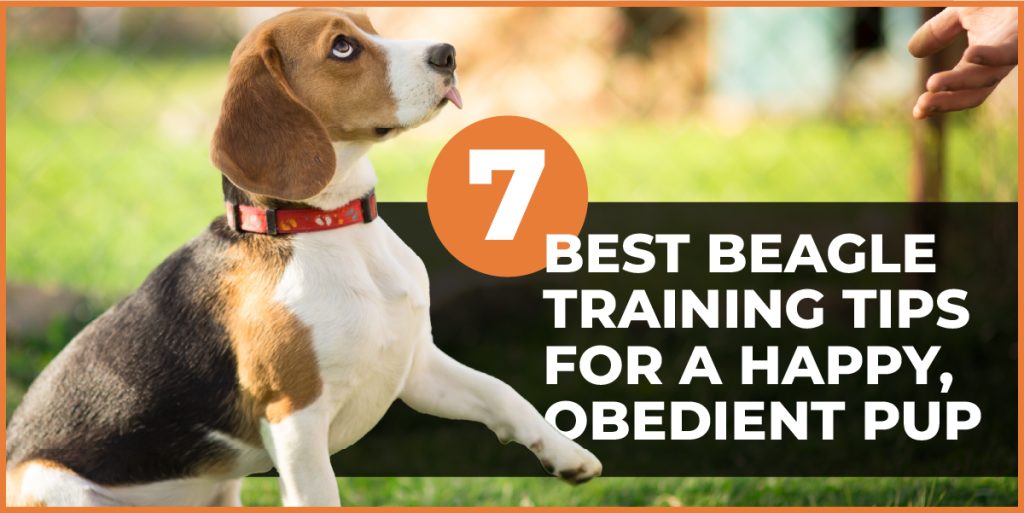Picture this: you've just brought home an energetic beagle puppy, its eyes full of mischief and a tail that won't stop wagging. You're smitten, but as the days go by, you realize that this bundle of joy is a bundle of boundless energy, always one step away from turning your home upside down. Training your beagle doesn’t have to be daunting.
With our focused beagle training tips, you’ll learn key strategies for honing your dog’s obedience without dampening their spirited nature. Dive into a collection of precise tips and tools crafted to navigate the unique quirks of the beagle breed, ensuring a well-behaved companion through consistency and positive reinforcement.
Key Takeaways
- Beagles’ independent, energetic, and scent-driven nature requires patient, consistent, and tailored training to manage their energy levels and take advantage of their intelligence for obedience training.
- Essential training equipment for beagles includes a treat pouch, padded harness, and a variety of leashes to aid in positive reinforcement, with a focus on smelly treats to maintain beagle’s attention during training sessions.
- Successful beagle training encompasses basic commands, effective crate and potty training, early socialization, controlling their hunting instincts with leash training, engaging their natural scent abilities, and providing ample mental stimulation to prevent destructive behaviors.
Find out how to train your beagle to be the well-behaved pup you desire – Read Free Report
Understanding Your Beagle's Nature
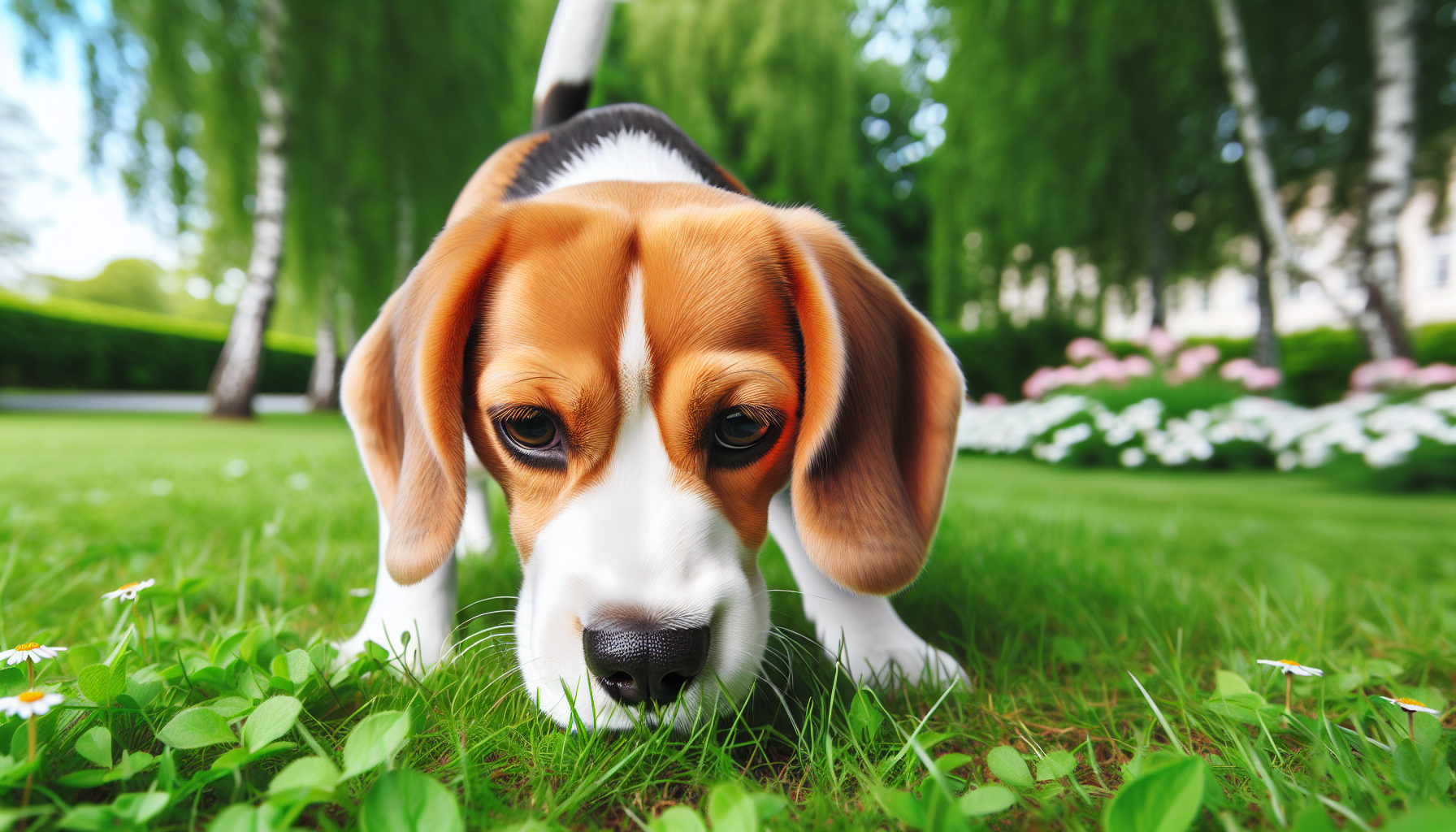
Image created with AI
Beagles are known for their scent-driven nature and hunting instincts, making training an essential part of raising a well-behaved and obedient beagle pup. But their independent nature as hunting dogs, coupled with their high energy levels, can present training challenges. Does this mean you’re set for a rocky road ahead? Not necessarily. With patience and the right techniques, you can turn these challenges into opportunities for bonding and growth with your intelligent dogs.
Daily walks and exercise play a crucial role in successful beagle training, especially when bringing a beagle puppy home. Regular exercise can help prevent common behavior problems by keeping your beagle occupied and managing their energy levels. Just like humans, beagles can become restless when they’re bored or have pent-up energy. But with a consistent exercise routine, you can keep your beagle happy and more receptive to training.
Grasping the nuances of your beagle’s nature lays the foundation for effective training. Armed with this knowledge, you can tailor your training sessions to your beagle’s unique traits and needs. Remember, every beagle is different, but understanding the common characteristics of the breed can give you a solid foundation for a successful training journey.
Essential Training Equipment
Prior to commencing your beagle’s training, ensure you have the necessary equipment. One essential item is a treat pouch, which should have the following features:
- Made from durable, easy-to-clean materials like nylon or canvas
- Multiple pockets and compartments for organized treat storage
- Adjustable straps for comfort
- Wide opening for quick treat access
This allows you to effectively use positive reinforcement during your training sessions.
When it comes to leashes, a padded harness like the Dog Copenhagen or fleece-lined Perfect Fit harness is recommended for a beagle in the early stages of loose leash walking. These harnesses provide comfort and control, essential for teaching your beagle proper leash manners. A 2-meter training leash is generally sufficient, but a 5-meter leash can be beneficial in the early stages of training, particularly when working on reducing dog barks and improving leash manners.
Finally, don’t forget about treats. Beagles are food-driven and will respond well to smelly treats during training sessions. These treats are more appealing to beagles and can keep their attention, making your training sessions more productive.
Basic Commands and Obedience
With your training equipment at hand, you can initiate teaching your beagle the basic commands. Beagles should be trained using positive, reward-based methods, as food is an excellent motivator for them, and maintaining their focus is crucial. But how exactly can you teach your beagle these commands?
For the “Sit” command, hold a treat above your beagle’s nose and move it towards the back of their head. This prompts them to sit. For the “Lie Down” command, take a treat to the ground in front of your pup, leading them to lie down to obtain the morsel. These techniques can be used for other commands as well, with the goal of teaching your beagle to associate specific actions with rewards.
Training sessions for young beagles or beagle pups should be kept to about five minutes, while sessions for adult beagles can be extended to 15 minutes. Before you start a training session, engage your beagle’s attention for five minutes. Follow the training with 10 minutes of play to make the experience enjoyable and rewarding. This will keep your beagle engaged and eager to participate in future training sessions.
#1 – Crate and Potty Training
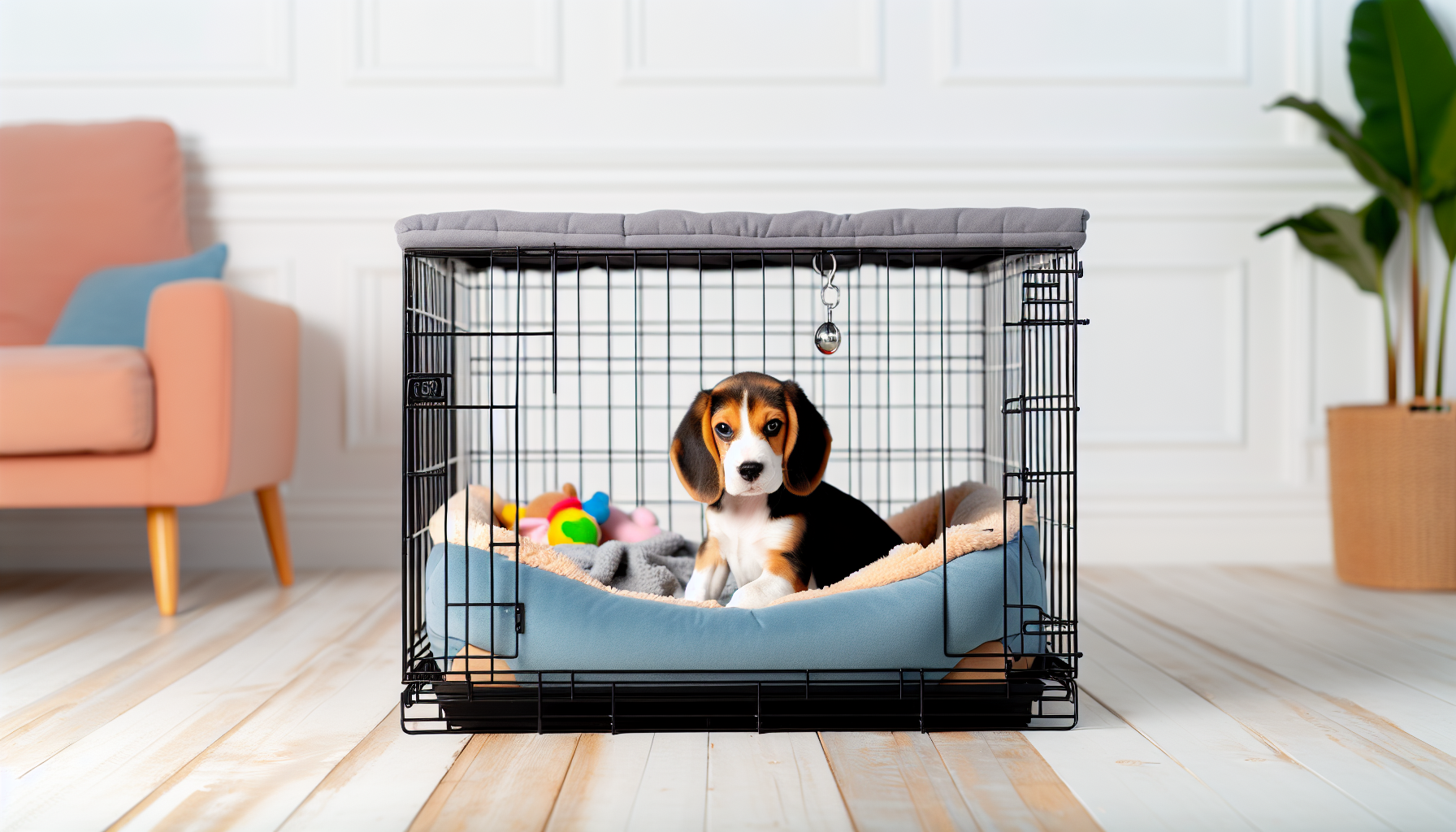
Image created with AI
Crate training also forms an integral part of beagle training, as it provides a secure, den-like space for your dog at home and in unfamiliar surroundings. When done correctly, crate training can also help with house training and prevent destructive behavior caused by loneliness or boredom.
Establishing a consistent ‘going’ schedule is an effective method for potty-training your beagle. Take your puppy out often, like every hour, and always reward them when they go potty in the designated area. This helps your beagle understand where they’re supposed to eliminate, reducing the chances of accidents in the house.
Potty training at night can be a bit more challenging, but there are strategies to help your beagle puppy. Here are some tips:
- Sleep close to them for reassurance
- Clear a path through the snow to the potty area outside to avoid discomfort
- Attend training classes to help with potty training and other essential skills
Remember, consistency, patience, and a close attention to your puppy’s needs are key when crate and potty training your beagle. Understanding your puppy’s behavior patterns and using puppy pads can also make the training process smoother, especially when it comes to training your beagle puppy.
#2 – Socialization and Confidence Building
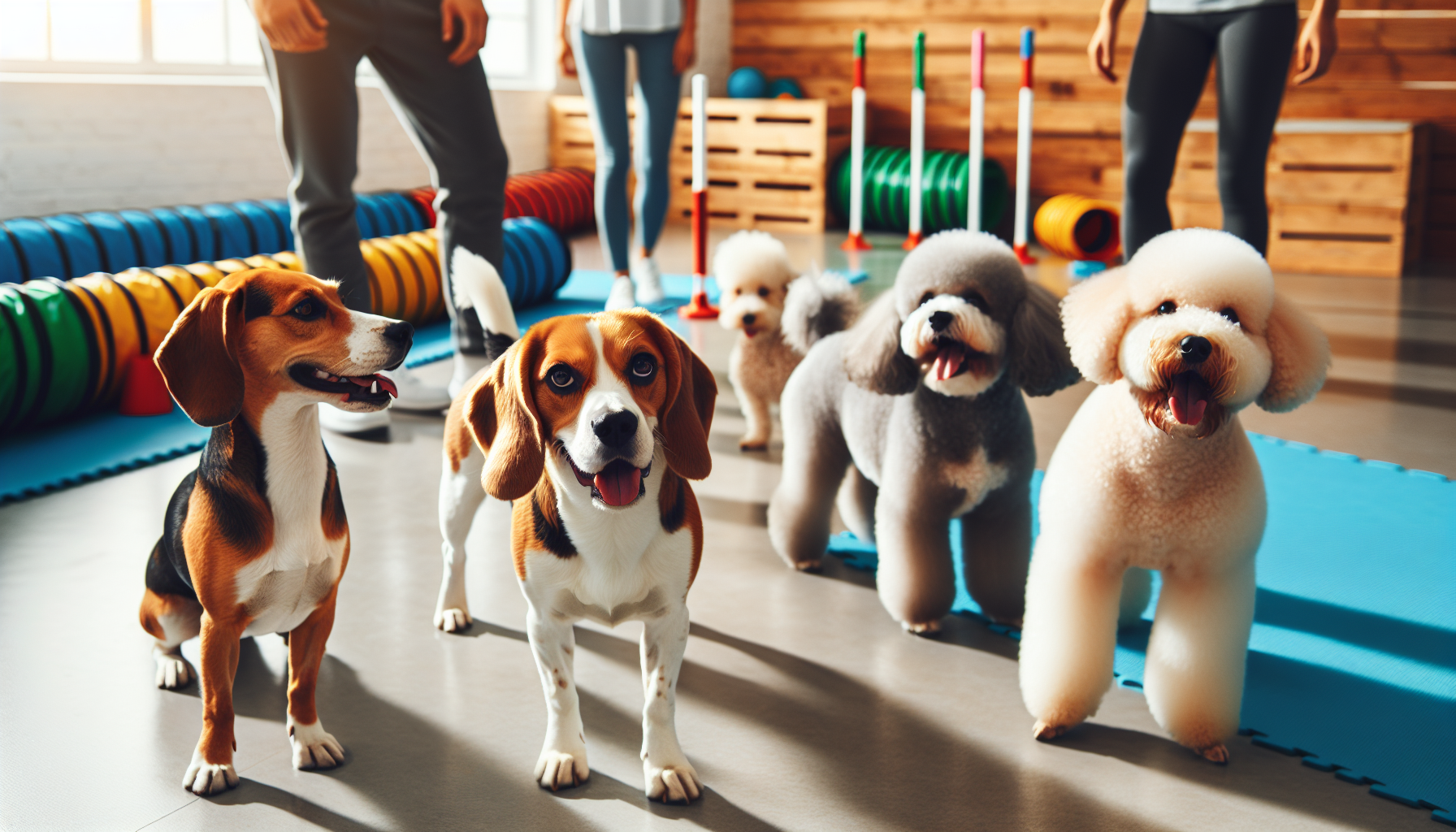
Image created with AI
It’s beneficial to start socializing your beagle at a young age to bolster their confidence and social aptitude. The optimal age to start socialization training for a beagle puppy is between eight and 16 weeks of age. During this period, they should get accustomed to:
- different people
- sounds
- shapes
- sights
Early socialization provides positive experiences for beagle puppies, aligning with their outgoing and pack-oriented nature. These experiences contribute to the development of their confidence and the enhancement of their social skills. So, how can you socialize your beagle effectively?
Introducing your beagle to other dogs through dog parks, play groups, and leash walks can help them become comfortable around other animals. Using treats, praises, and toys to reward curiosity and calm behavior in new situations is also beneficial. You can also expose them to different people, places, sights, and sounds, or enroll them in well-run puppy classes to further enhance their socialization skills.
#3 – Leash Training and Preventing Wandering
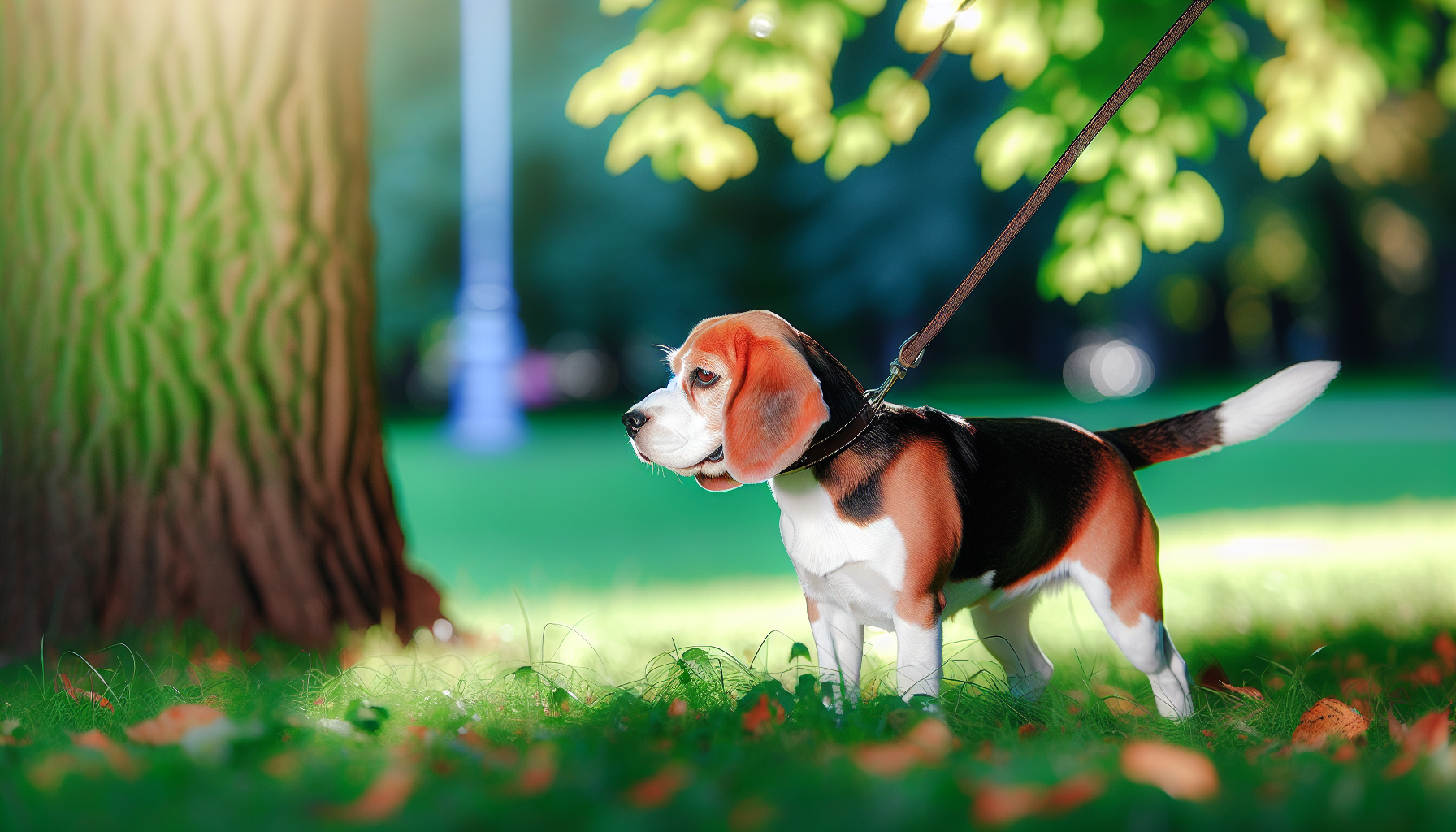
Image created with AI
Additionally, leash training forms a significant part of beagle training. Techniques for leash training a beagle include:
- Using a harness
- Using treats for positive reinforcement
- Starting training at a young age
- Practicing patience
- Practicing attention and self-control exercises
But you might be wondering: what types of leashes should you use for beagle training?
There are several leashes recommended for training beagles, including:
- Petsafe Dog Leash for puppies
- Kurgo Dog Leash for well-trained beagles
- BAAPET Strong Dog Leash for energetic dogs
- Traditional 6-foot Nylon or leather leashes for general training
These leashes are designed to provide control and comfort during your training sessions.
Beagles should always be contained or restrained to prevent them from following their strong hunting instincts and curiosity, owing to their remarkable sense of smell. If left unleashed, beagles might:
- Wander off to investigate an intriguing scent
- Chase after small animals
- Get lost or injured
- Cause potential safety issues
It is important for beagle owners to keep their beagle on a leash or in a securely fenced area to ensure their safety.
To prevent your beagle from wandering, using consistent recall commands such as ‘come’ or ‘here’ along with positive reinforcement when the command is obeyed can be effective. This helps your beagle understand that they should return to you when called, reducing their tendency to wander off.
#4 – Encouraging Natural Abilities
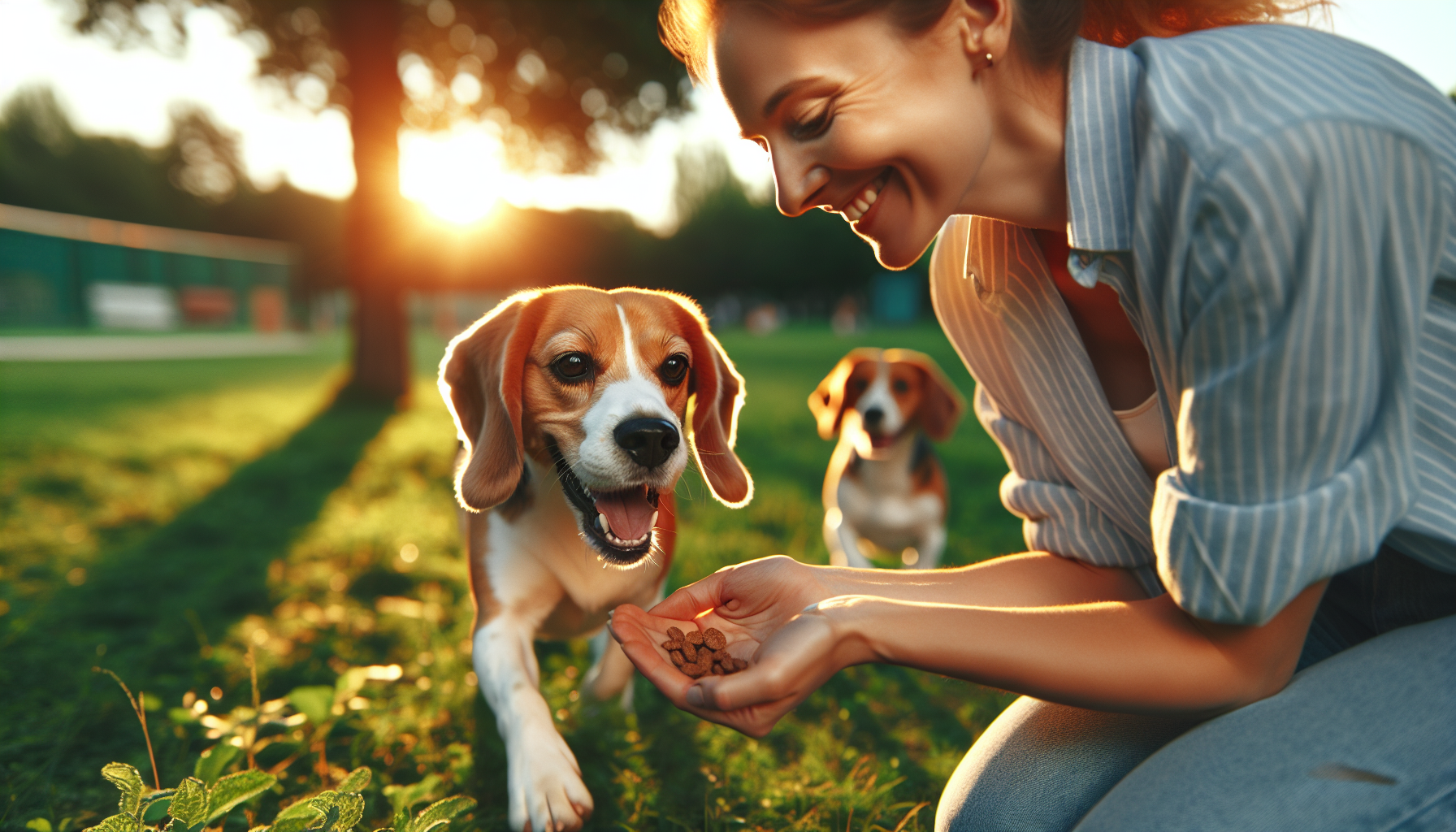
Image created with AI
Encouraging their inherent scent-tracking abilities is a delightful aspect of owning a beagle. Interactive games like Barn Hunt, Scent Work, and Find the Food tap into a Beagle’s natural scent-tracking abilities and offer enjoyable ways to stimulate and exercise their acute sense of smell. But how can you train your beagle to participate in these games?
Training your beagle for hide-and-seek involves:
- Having someone hold your dog and command it to ‘find’ while you hide nearby.
- As your dog gets better at the game, you can increase the difficulty by hiding further away or in more obscured spots.
- Eventually, your beagle will learn to seek you out using its powerful sense of smell.
Involving your Beagle in AKC activities can provide mental stimulation, be enjoyable for both dog and owner, and help to build a strong bond. Activities such as the Deer Hide Method, where you introduce and hide a deer scent for your beagle to find, can further enhance their remarkable tracking skills.
#5 – Consistency and Repetition
In beagle puppy training, the importance of consistency and repetition cannot be overstressed, as these reinforce schedules and facilitate the learning of desired behaviors. These practices help in establishing clear expectations, which is particularly important for a breed known for its stubbornness and independence.
If consistency and repetition are not maintained in beagle training, your beagle may struggle to understand what is expected of them, leading to stubbornness or disobedience. This lack of clear expectations can make obedience training more challenging.
Establishing a consistent routine and using positive reinforcement techniques consistently are effective strategies for maintaining consistency in beagle training. Patience is also crucial in order to reinforce desired behaviors effectively.
#6 – Dealing with Common Challenges
Beagles may seem stubborn during training due to their breed-specific traits and instincts. But remember, this doesn’t mean your beagle is intentionally being difficult. They’re simply following their natural instincts. To address this behavior, commands should be given only during training sessions and not randomly.
Being easily distracted during dog training is another common challenge with beagles due to their breeding instincts, which drive them to follow their noses. This can make training sessions challenging, but with the right strategies and a lot of patience, you can make training sessions more productive.
Resource guarding is a behavior where a beagle refuses to relinquish an item, such as a toy or a piece of tissue. To prevent this, train your beagles to exchange items they possess for rewards. This discourages possessive behaviors over their resources, making your training sessions smoother and more effective.
7 – Enrichment Activities and Mental Stimulation
Providing mental stimulation is paramount for beagles as it serves to ward off boredom and destructive behavior stemming from lack of mental engagement. Without sufficient mental stimulation, beagles can become restless and may resort to destructive behaviors such as chewing.
Effective mental stimulation activities for beagles include:
- playing fetch
- hide and seek
- using stuffed Kong toys
- hiding treats around the home
- allowing them to watch the outside world from a window
These activities not only provide mental stimulation but also strengthen the bond between you and your beagle.
Toys that are recommended for a beagle’s mental stimulation include treat-dispensing toys, interactive puzzle toys, and toys that create sounds when rolled or shaken, such as the Wobble Wag Giggle Ball. These toys can keep your beagle engaged and mentally stimulated, reducing the likelihood of destructive behaviors.
Summary
In conclusion, training a beagle can be a rewarding experience, filled with challenges and triumphs. Understanding your beagle’s nature, being consistent in your training, providing mental stimulation and enrichment activities, and dealing with common challenges can lead to a happy, obedient pup. Remember, every victory, no matter how small, is a step towards a well-behaved beagle. So embrace the journey, and enjoy the unique experience of raising a beagle.
Frequently Asked Questions
Are beagles easy to train?
Beagles can be more challenging to train compared to other breeds due to their independent nature and stubbornness. Our free beagle training report can provide more insight for you as you embark on this journey with your beagle puppy.
How do you discipline a Beagle?
To discipline a Beagle, use direct interactive punishment when catching them engaging in incorrect behavior, such as using a loud noise. Additionally, keep commands simple and always reward good behavior with treats and praise.
What are the do's and don'ts of a Beagle?
Always keep your Beagle on a leash when outside of a fenced yard, as they cannot be let off-leash during walks or hikes. This is important for their safety and well-being.
What should I train my Beagle to do?
Train your Beagle to learn basic commands like sit, stay, come, and down using positive reinforcement techniques such as treats or praise. This will help them respond quickly and behave well in different situations.
What are the distinctive traits of beagles?
Beagles are known for their scent-driven nature and hunting instincts, making them excellent tracking dogs.
Learn how to train your beagle to be the well-behaved dog you desire –> Access our Free Report
Shop for beagle-themed products and gifts that beagle enthusiasts will love.

